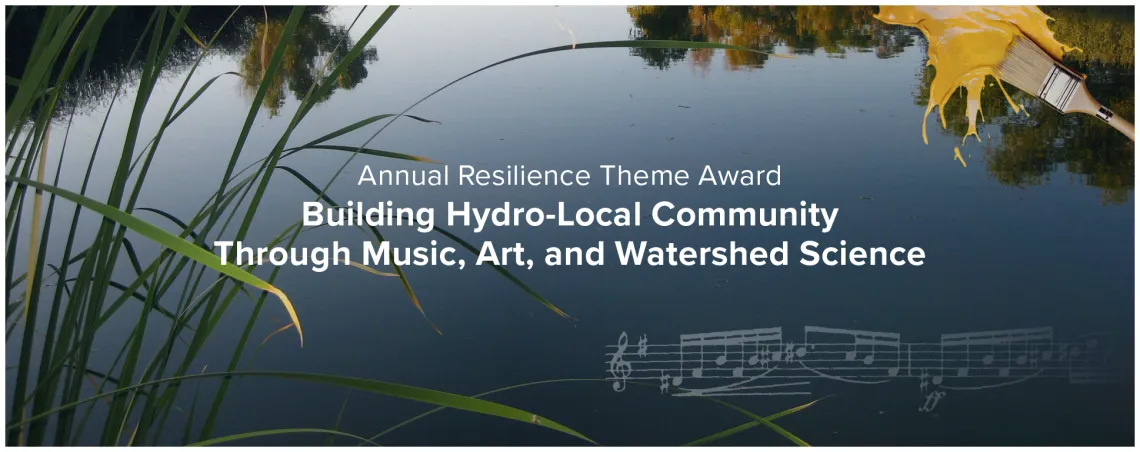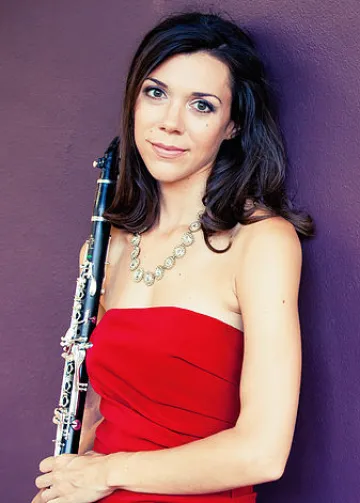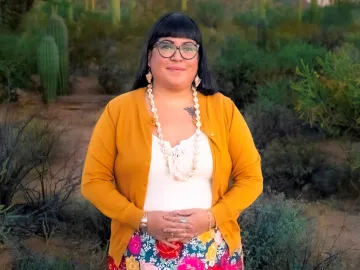Building Community Through Music, Art, and Watershed Science
Announcing the Second Annual Resilience Theme Award

The winners of the second AIR Annual Resilience Theme Grant seek to inspire community stewardship of local watersheds through music, art, and science.
The project, Building Hydro-Local Community Through Music, Art, and Watershed Science, is led by principal investigator Sara Fraker, an associate professor in the University of Arizona School of Music, along with co-investigators Yuanyuan (Kay) He, a composer and assistant professor in the School of Music, Jackie Glazier, an associate professor in the School of Music and clarinetist, Carissa DiCindio, an associate professor in the School of Art, and Neha Gupta, an assistant research professor within AIR and the Department of Hydrology and Atmospheric Sciences.
The arts-science integration began one evening when Glazier approached Fraker, who had recently collaborated with the Arizona Laboratory of Tree Ring Research to compose a piece inspired by the growth patterns of trees. Glazier said: “our next project needs to be water.”

Sara Fraker
Fraker spent the next year assembling a multidisciplinary team of creatives, scientists, and community organizations passionate about community connection and water stewardship.
“All of us believe that it’s important for people to understand their local watersheds and the roles they play in shaping our lives, historically and in the present,” she said.
The Annual Resilience Theme Award is administered by the Arizona Institute for Resilience and provides interdisciplinary U of A teams with support to work on a collaborative project throughout an academic year, integrating research with community outreach and impact.
“The second AIR Annual Resilience Theme’s emphasis on water and watershed stewardship is an almost perfect sequel to our first Annual Resilience Award theme in 2023-2024, which was centered on soil health,” said AIR Director Sharon Collinge. “All elements of the environment are interconnected, as are these inspirational projects. I am so excited to see this come to fruition over the next year!”
Through musical compositions and performances, workshops, and art, the team hopes to inspire greater interest in watershed stewardship and the conservation of water and land through practices such as rainwater harvesting, river cleanups, and restoration efforts.
“We’re really excited about how many different disciplines and perspectives are involved with this work,” Fraker said. “Everyone contributes something unique and powerful.”

Jackie Glazier
Jacelle Ramon-Sauberan plays a bridging role between local and ancestral community knowledge and outside organizations. Ramon-Sauberan is an instructor at Tohono O’odham Community College, Education Development Liaison at Kitt Peak National Observatory, and recently completed her doctorate in American Indian Studies at U of A. Her dissertation explored the history of land and water in San Xavier, the first written document to recount this legacy.
“A lot of times, we as Indigenous people are an afterthought,” said Ramon-Sauberan. “But Sara and Jackie wanted me involved in this project from the very beginning.”
Larry Fisher, research professor emeritus of environmental policy within the School of Natural Resources and the Environment, brings inspirational perspective and experience in watershed management and connecting with communities.
Meanwhile Gupta will work with the team on the research component of the project centered on the interface between art, science, and community engagement.
“In my community in San Xavier, we’ve started having conversations about climate change, which is described differently within our way of life than in Western culture,” said Ramon-Sauberan. “It’s incredibly important to continue to have these conversations and engage our youth as we learn about our history, talk about the present, and plan for the future.”

Jacelle Ramon-Sauberon.
Leslie Ann Epperson
Through seed funding from the Pima County International Human Environment Observatory, the team will continue to work with the France-based Centre Nationale de la Recherche Scientifique on eco acoustic research, which records natural environments to track shifts in biodiversity over time.
The project also will build upon the U of A’s connection with the Cienega Watershed Partnership, which facilitates research and community collaborations in the lands southeast of Tucson, especially within Las Cienegas National Conservation Area.
Finally, the team will bring its research, awareness, and conservation messages about water to the Tucson community through music and art.
“The arts are sometimes able to understand and communicate concepts in an emotional way that doesn’t always come through a scientific article or diagram,” Fraker explained.
Heather (Bird) Harris, a community-based and environmentally themed visual artist who makes paint from earth-based pigments, will come for a residency at the Arizona School of Art and work with Tohono O’odham students to create art of and with the San Xavier land.
The team will create multiple musical compositions, including a reed trio piece for oboe, clarinet, bassoon and electronics integrating acoustic recordings collected by CNRS scientists in the Santa Cruz River watershed. Harris will create accompanying video projections that show her paint-making process with locally sourced earth pigments.
He, an assistant professor in the Arizona School of Music, will compose a work for the Tucson Symphony Orchestra which will become the centerpiece of the TSO’s 2025 Young People’s Concerts. It will include a spoken narration created by Arizona Regents Professor Emerita of Creative Writing, Alison Hawthorne Deming, in collaboration with Ramon-Sauberan and Fisher. A version for high school bands will involve youth in both the performance and the exploration of connections between land and water and music.
Fraker’s own curiosity about these connections led her to volunteer with the Watershed Management Group, a Tucson-based nonprofit helping to educate and support sustainable livelihoods and a community partner for the project.
With WMG, she learned about efforts to remove Arundo donax, an invasive cane inhabiting many of Southern Arizona’s watersheds. It's the same species that oboes, clarinets, and bassoons use to make the reeds, or mouthpieces, that produce their sounds.

